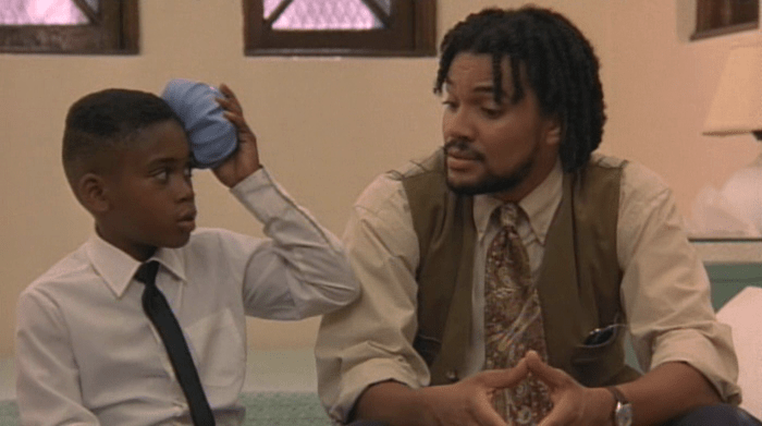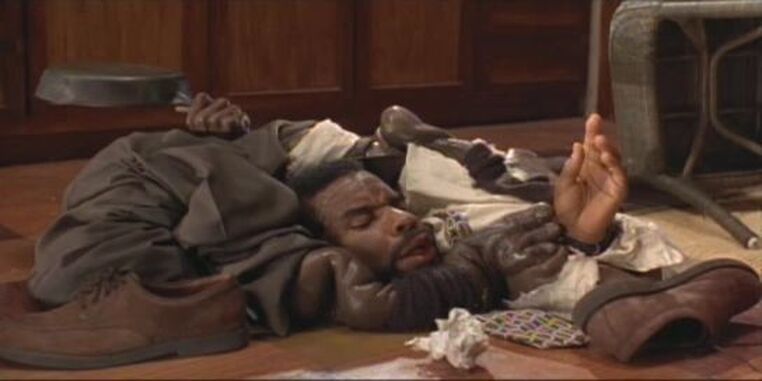 The thing about dated horror films is that we most often adore them because of the nostalgia, because they remind of us of who we were when we first watched them, or where we lived, or of how innocent our fear was at the time… ...Not so with director Rusty Cundieff’s Tales from the Hood, released 25 years ago on May 24th, 1995. When I rewatched it, I totally expected a campy, fun horror comedy film like the show on which its title is based, Tales from the Crypt. But no, Tales from the Hood, that shit is still scary. In commemoration of the 25-year anniversary this bomb anthology film written by Cundieff and Darin Scott, here are the top 8 aspects of its horror that really hold up. SPOILERS AHEAD 1. Ethnic identity (but especially the Black identity) trumps other identities As a person who is not Black, I can only speak to this from the outside. (I don’t want to mislead y’all: I’m brown, but my experience is a different experience than the Black experience.) In the first segment, “Rogue Cop Revelation”, we meet Clarence Smith (Anthony Griffith), a new recruit for the policeforce in L.A. After the policemen he’s with kill a city councilman and Black rights activist, Smith says they should be reported. I don’t have to tell you, dear reader, that police brutality and abuse of power is still very much a thing. I mean, the threat of corrupt or racist police is what makes the whole ending of Get Out work. But what the policemen say next makes Smith lose his sense of self. They tell Smith that he can’t violate “the code.” That means by unwritten law, he’s not allowed to report them for their crimes. “The code” goes in direct contrast with the no-snitching policy in every hood. (The idea that though you might fight with your family or neighbors, when someone from the outside comes in, you have to be on the same team, no matter what.) Smith is immediately conflicted between siding with his job as a policeman and his ethnicity and morality, which lie with Moorehouse (Tom Wright). He sides with the brutal policemen, under duress. He chooses wrong. Moorehouse haunts him throughout this segment. The issue of ethnic identity, and Blackness in particular, as an identity that trumps other identifying communities (like the policeforce, your workforce, etc.) is one that still permeates our culture and is very well depicted in Tales from the Hood. 2. The intersection of the supernatural and Christianity… otherwise known as the cultural re-appropriation of Caribbean (particularly Haitian) Voodoo beliefs I don’t know about y’all, but my mother is Catholic. That means I got in trouble when I was a kid for asking for a Ouija board for my birthday. It was devilish. But a Magic 8 Ball was okay. That toy is sitting on my bar right now. And my mom loves to watch the women on Youtube read the tarot of her Zodiac sign. What gives? Where’s the line? What’s really interesting, especially in the realm of horror, is the intersection of what we consider “superstition” or “the supernatural” with Christianity. Horror movies in general have a lot to say about the coexistence of religion with folk images that mainstream culture regards as superstitious, but are really from another religion, usually West African, but not always. In particular, horror films show the Haitian Voodoo belief system appropriated for the sake of horror in multiple zombie movies. (I could go into deeeeep detail on the history of zombies, but I’ll let you read that here, instead, since it’s not directly relevant to this argument). In short, the zombie is a historically Black monster, but they’re not used in horror in the traditional, Haitian Voodoo sense in this film. Rather, we have the resurrected corpse of Moorehouse who haunts Clarence because he did not help, and he wants vengeance. Who can blame him? The other, most famous example of Haitian Voodoo beliefs that has been appropriated is, of course, that of the Voodoo Doll, or an effigy of a person which the priest or priestess can harm in order to hurt the person they want to curse. We definitely have that in Tales from the Hood. In the segment “Boys do Bruise,” the little boy, Walter (Brandon Hammond), destroys his boogeyman through an effigy. Though, again, not only associated with voodoo, when he draws the image of his “monster,” in this case his abusive father-figure, and then folds the paper, he breaks the man’s bones. He sets it on fire, and the boogeyman seems to melt. Gnarly. I bet that wasn’t where you thought I was headed when I brough up Voodoo dolls, though: you probably thought I was going to talk about the possessed dolls in the segment, “KKK Comeuppance.” But those aren’t a part of Voodoo culture as far as I know. That’s something else. The possessed dolls aren’t effigies: they’re possessed by the vengeful spirits of murdered slaves. 3. The Uncle Tom trope I won’t linger on this trope too long since it is, after all, a trope. In case you’re unfamiliar with the term, The Uncle Tom trope is essentially a traitor to the Black race, and usually for the reason of gaining some kind of favor with white people in power. In another, more specific example of being punished for going against ethnic identity, we see the campaign manager of Duke Metger (Corbin Bernsen), a racist southern senator, take the heat for this in that he enables the former KKK member and current senator to make his home in a plantation. And, of course, enables all his bullshit racist policies (we’re led to assume). 4. Problematic Politicians Sigh. When I say “problematic” I mean “barely-closeted racist” politicians. I wish, I totally wished, hoped, and prayed, this will no longer be a thing, but it is. And it’s presented well in Tales from the Hood by this politician, Duke Metger, who disregards the protests of his Black neighbors and moves into a plantation when he is elected senator, stating that if he doesn’t MEAN something as racist, then it ISN’T racist… which is, we all know, not how the world (or even communication, geez) works. 5. Total disregard of historical tragedy Look, y’all, I’m from the south, okay. I know that whole argument of “history, not hate,” and while I totally believe that some people believe that is the case and have no ill intentions… it’s just not the way things are. Like, yeah, maybe you aren’t actively meaning to send a middle finger to every brown person in a fifty mile radius by flying your Confederate flag, but you also know that we all take it as such. I went on that whole digression to say this: plantations are historical, yes, but they’re historic of a time and symbolic of an era in which its main qualification is the enslavement of an entire ethnic group. So, maybe a plantation can be a museum—that I can support. I don’t want to GO to it, but I support it existing. But LIVING in one of them is the equivalent of buying and living in a murder house and celebrating the historic period that enabled that murder. (Basically, do not use a plantation as your wedding venue, ladies.) It’s not just the historical significance that makes this action of the senator particularly appalling, though: all of his neighbors warn him not to move into that house, that it was the site of a slave uprising and subsequent massacre and it is haunted AF. But, like little Walter says to his teacher about his boogeyman, “He said you wouldn’t believe me.” 6. The Black person on the news depicted as a stereotype One of the many neighbors who tries to warn Metger about moving into the plantation is a farmer. You know, the very backwoods farmer in a straw hat thrilled to be on television and selected by the news anchor undoubtedly to embarrass him. You know the one. Nowadays, it’s more ‘do-rag and hair curlers or scarf than straw hat, but there’s a reason why Black people on TV news shows are always memed: they’re made into stereotypes. I hate that. (Though The Unbreakable Kimmy Schmidt did subvert the hell out of that trope, and I loved it.) My point is, it’s STILL A THING, no matter how true what they’re saying is. And this farmer on the news says my favorite—and the truest—line in the whole film, of the murdered slave spirits: “They want reparations, and they have no use for money.” 7. The really spooky practical effects I’m just going to do the rapid-fire comments here about how the practical effects pretty much withstood the test of time: the dolls. How did they do that? How did they do the shadows on the wall? What about Walter’s burned-up, twisted-up boogeyman corpse for which they’re (apparently) having an open-casket memorial? And I’m not even sure how to attack the final episode, “Hard-Core Convert,” in which the gangster Krazy K (Lamont Bentley) is basically Clockwork-Oranged with a montage of all of the trauma of the Black experience. (By the way, my co-host named our episode of our horror comedy podcast about this film, “Bear Witness, You Weak Bitch” specifically about this segment. And in full disclosure, I developed a lot from her insights for this article.) All right, but the special effects, though… no. SMH. The special effects are the only reason why I support a remake of Tales from the Hood. Everything except the special effects HOLDS UP. - Remember when Moorehouse resurrects himself and he LITERALLY blew up their spot? - The snake tongue coming through the undertaker’s teeth. Make it better. - The slapstick fights with special effects like Bonanza--STOP IT. - The melting down of Walter’s boogeyman. Such a rewarding pay-off and so weirdly executed. 8. The frame story The mortuary frame story is really the only similarity between this film and Tales from the Crypt. It WORKS, though. When the gangsters come to shake down the funeral director (Clarence Williams III), he instead totally creeps them out by showing them the bodies he has recently embalmed, and telling them each of the episodes above. It’s not until they see their own bodies in the mortuary that we realize what has happened. It’s more than a Ghost-of-Christmas-Future deal: the mortician reveals that they are in hell. That means hell is a funeral home in which we have to hear the myriad sufferings of Black people. I think that’s the main takeaway for the audience, especially people who stand by why atrocious shit happens for no reason. The thing is, we are all so complicit because racism has been so institutionalized. At what point in time could we have undone all of this horror, and how ongoing will the cascading failures depicted in Krazy K’s montage be? There is no real answer except for to say this frame story, and the heart that it inhabits, is absolutely reason enough to rewatch Tales from the Hood now, on its 25th anniversary. By Mary Kay McBrayer
0 Comments
Leave a Reply. |
Archives
March 2023
|









 RSS Feed
RSS Feed